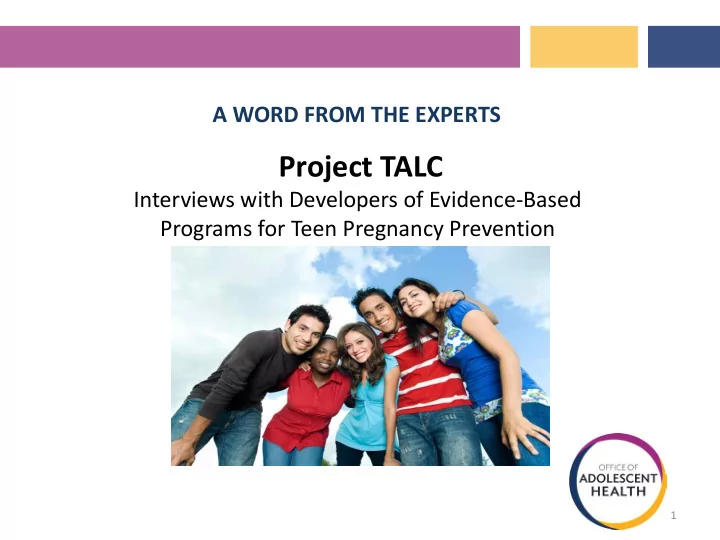

A WORD FROM THE EXPERTS Project TALC Interviews with Developers of Evidence-Based Programs for Teen Pregnancy Prevention 1
This webinar was developed by Child Trends under contract #GS-10F-0030R for the Office of Adolescent Health; US Department of Health and Human Services as a technical assistance product for use with OAH grant programs . 2
Disc la ime r Inclusion on the HHS Teen Pregnancy Prevention Evidence Review does not indicate HHS or OAH endorsement of a program model. 3
Pro je c t T AL C Mary Jane Rotheram-Borus, Ph.D. Director of the Global Center for Children and Families David Geffen School of Medicine 4
Pro g ra m de sc riptio n Program goals : Key components: Less emotional distress Social skills Fewer behavior Set expectations re: problems course of disease Less substance abuse Establish daily routines Fewer & later babies Delivery methods: Target population: Small group Low income Parent & youth together & alone Ethnic minorities Youth with ill parent 5
Pre vio us e va lua tio n re sults Study #1 Population: Youth in NYC Findings: Parents have less drug use, depression, better parenting o Youth have fewer & later babies o Less substance use & emotional distress o More likely to finish school o Study #2 Population: LA Latina & Black mothers with HIV & their adolescents Findings: Less depression over time Study #3 Population: South African pregnant youth, Thailand, China, Haiti, Zimbabwe Findings: Better infant growth at 1 year in South Africa Other researchers have different findings in each country o 6
T a rg e t po pula tio n Evaluated populations o African American, Latina, & Caucasian o Parents with HIV & their Adolescents o Families in highly stressful conditions, including – Discrimination & stigma – Terminal diseases – Substance use histories – Low income Target populations o Families coping with a chronic illness (e.g. HIV) o Adolescent children of parents affected by HIV 7
Se tting s Evaluated settings o Community settings o Hospitals & clinics o Home visits (Africa) Other settings o Home visits o Schools o Juvenile justice settings Always delivered by paraprofessionals Same principles, elements, & processes across countries & populations 8
Ada pta tio ns Theory: Families change slowly, over time, in relationships, with small steps, with opportunities & rewards. 9
Po te ntia l a da pta tio ns Potential adaptations o Any institutional or community settings – Churches, NGO, clinics, hospitals, o Cultural relevance – Highly relevant in cultures with any stigma towards illness o Language Note: TPP grantees must obtain prior – Local language approval from OAH o Target population for any adaptions. – Data is only available on adolescents o Researchers have mounted in Thailand, China, Haiti, & Zimbabwe 10
Sta ffing a nd tra ining c o nside ra tio ns Staffing considerations o Two paraprofessionals/group o Training in cognitive behavioral change strategies (see earlier model) o Good social skills, pragmatic problem solving ability, knowledge & ability to apply cognitive-behavioral theory Training considerations o Ongoing monitoring via mobile phone for data-informed supervision o Allow drop-in groups & link to other services; coming once will lead to 75% attendance o “Not in my backyard” due to potential stigma 11
Cha lle ng e s a nd stra te g ie s fo r suc c e ss Common challenges o Paraprofessionals want to share knowledge, not apply problem solving so that family can implement change over time o Iterative quality improvement is critical; need data informed supervision Strategies for success o Use tokens as a demand characteristic for praise o Do not demand replication of scripts in a manual; allow personal training, but only after the concept is integrated into a change model o Use sport & sports coaches to intervene with men 12
Re c e nt o r pla nne d re visio ns Recent or planned curriculum revisions o We use the house model to teach foundational skills, the content of the disease related challenges, & allowing cultural tailoring o We are experimenting with a very different implementation mode for men: soccer games o Ability to apply practice elements and principles is basic to implementation o Paraprofessionals must understand & be able to apply cognitive-behavioral strategies to each person’s life 13
Additio na l re so urc e s HHS Teen Pregnancy Prevention Evidence Review o http://tppevidencereview.aspe.hhs.gov/ Link to implementation report o http://tppevidencereview.aspe.hhs.gov/document.aspx?rid= 3&sid=162&mid=1 Link to developer’s website o http://chipts.ucla.edu/projects/talc-nyc/ 14
T ha nk yo u! Mary Jane Rotheram-Borus, Ph.D. Director of the Global Center for Children and Families David Geffen School of Medicine mrotheram@mednet.ucla.edu 15
Recommend
More recommend